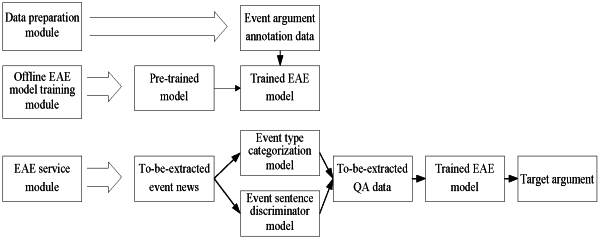| CPC G06F 16/3344 (2019.01) [G06F 18/214 (2023.01); G06F 18/2415 (2023.01); G06V 20/20 (2022.01); G06V 20/43 (2022.01)] | 9 Claims |

|
1. An event argument extraction (EAE) method, comprising:
acquiring a to-be-extracted event content; and
performing argument extraction on the to-be-extracted event content based on a trained EAE model, to obtain a target argument of the to-be-extracted event content;
wherein the trained EAE model is obtained by training a pre-trained model with event news annotation data and a weight of each argument annotated in the event news annotation data,
wherein the trained EAE model is obtained at least in following manner:
training the pre-trained model in accordance with the event news annotation data and a loss function, to obtain the trained EAE model, wherein the loss function is associated with a predicted probability value, predicted by the pre-trained model, of each argument annotated in the event news annotation data and the weight of each argument annotated in the event news annotation data,
wherein the performing argument extraction on the to-be-extracted event content based on a trained EAE model, to obtain a target argument of the to-be-extracted event content comprises:
predicting an event type of the to-be-extracted event content using a trained event type categorization model;
predicting an event descriptive sentence of the to-be-extracted event content using a trained event sentence discriminator model;
constructing to-be-extracted question answering (QA) data corresponding to the to-be-extracted event content based on the event type, the event descriptive sentence, an argument role corresponding to the event type, and a preset QA format, wherein a format of the to-be-extracted QA data matches the preset QA format, and the to-be-extracted QA data comprises the event descriptive sentence of the to-be-extracted event content, the event type of the to-be-extracted event content, and the argument role corresponding to the event type; and
inputting the to-be-extracted QA data to the trained EAE model, and performing argument extraction using the trained EAE model, to obtain the target argument.
|